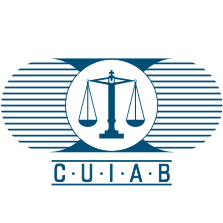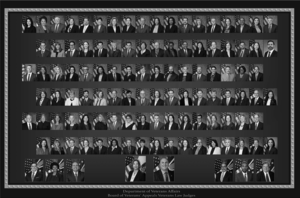
United States appellate procedure involves the rules and regulations for filing appeals in state courts and federal courts. The nature of an appeal can vary greatly depending on the type of case and the rules of the court in the jurisdiction where the case was prosecuted. There are many types of standard of review for appeals, such as de novo and abuse of discretion. However, most appeals begin when a party files a petition for review to a higher court for the purpose of overturning the lower court's decision.
Adjudication is the legal process by which an arbiter or judge reviews evidence and argumentation, including legal reasoning set forth by opposing parties or litigants, to come to a decision which determines rights and obligations between the parties involved.
The European Patent Convention (EPC), the multilateral treaty instituting the legal system according to which European patents are granted, contains provisions allowing a party to appeal a decision issued by a first instance department of the European Patent Office (EPO). For instance, a decision of an Examining Division refusing to grant a European patent application may be appealed by the applicant. The appeal procedure before the European Patent Office is under the responsibility of its Boards of Appeal, which are institutionally independent within the EPO.
An unfair labor practice (ULP) in United States labor law refers to certain actions taken by employers or unions that violate the National Labor Relations Act of 1935 29 U.S.C. § 151–169 and other legislation. Such acts are investigated by the National Labor Relations Board (NLRB).
The Virginia General District Court (GDC) is the lowest level of the Virginia court system, and is the court that most Virginians have contact with. The jurisdiction of the GDC is generally limited to traffic cases and other misdemeanors, civil cases involving amounts of under $25,000. There are 32 GDC districts, each having at least one judge, and each having a clerk of the court and a courthouse with courtroom facilities.
Social Security Disability Insurance is a payroll tax-funded federal insurance program of the United States government. It is managed by the Social Security Administration and designed to provide monthly benefits to people who have a medically determinable disability that restricts their ability to be employed. SSDI does not provide partial or temporary benefits but rather pays only full benefits and only pays benefits in cases in which the disability is "expected to last at least one year or result in death." Relative to disability programs in other countries in the Organisation for Economic Co-operation and Development (OECD), the SSDI program in the United States has strict requirements regarding eligibility.

The United States Court of Appeals for Veterans Claims is a federal court of record that was established under Article I of the United States Constitution, and is thus referred to as an Article I tribunal (court). The court has exclusive national jurisdiction to provide independent federal judicial oversight and review of final decisions of the Board of Veterans' Appeals.
Richardson v. Perales, 402 U.S. 389 (1971), was a case heard by the United States Supreme Court to determine and delineate several questions concerning administrative procedure in Social Security disability cases. Among the questions considered was the propriety of using physicians' written reports generated from medical examinations of a disability claimant, and whether these could constitute "substantial evidence" supportive of finding nondisability under the Social Security Act.

R v Panel on Take-overs and Mergers; Ex parte Datafin plc [1987] QB 815 is a UK constitutional law, company law and administrative law case of the Court of Appeal. It extended the scope of judicial review in English law to private bodies exercising public functions. Before Datafin, only bodies established by statute could be judicially reviewed, while private bodies could only be sued for their actions in contract or tort law.
The Virginia Circuit Courts are the state trial courts of general jurisdiction in the Commonwealth of Virginia. The Circuit Courts have jurisdiction to hear civil and criminal cases. For civil cases, the courts have authority to try cases with an amount in controversy of more than $4,500 and have exclusive original jurisdiction over claims for more than $25,000. In criminal matters, the Circuit Courts are the trial courts for all felony charges and for misdemeanors originally charged there. The Circuit Courts also have appellate jurisdiction for any case from the Virginia General District Courts claiming more than $50, which are tried de novo in the Circuit Courts.

The United States has compensated military veterans for service-related injuries since the Revolutionary War, with the current indemnity model established near the end of World War I. The Department of Veterans Affairs (VA) began to provide disability benefits for post-traumatic stress disorder (PTSD) in the 1980s after the diagnosis became part of official psychiatric nosology.

Cardona v. Shinseki was an appeal brought in the United States Court of Appeals for Veterans Claims (CAVC) of a decision by the Board of Veterans' Appeals upholding the denial of service-connected disability benefits for the dependent wife of a female veteran. The United States Department of Veterans Affairs denied the disability benefits based on the definition of "spouse" as "a person of the opposite sex" under federal statute. On March 11, 2014, the CAVC dismissed the case as moot after the Secretary of Veterans Affairs advised the Court that he would neither defend nor enforce the federal statute. Cardona subsequently received full payment of her spousal benefits, retroactive to her date of application.

The Bureau of Pensions Advocates (BPA) is a nation-wide, semi-independent law firm within Canada's Department of Veterans Affairs. In place in one form or another since October 1, 1930, it provides free counsel and legal representation to Canadian Veterans and members of the Royal Canadian Mounted Police in appeals before the Veterans Review and Appeal Board regarding Veterans Affairs Canada decisions on their disability pension and award applications.

The California Unemployment Insurance Appeals Board is a quasi-judicial administrative court in the U.S. state of California which hears appeals from determinations on unemployment insurance claims and taxes by the Employment Development Department. It is governed by a five-member Board, of which three are appointed by the Governor, one is appointed by the Speaker of the Assembly and one by the Senate President pro tempore. The Board was initially formed in 1943.

In some jurisdictions, a petition for review is a formal request for an appellate tribunal to review the decision of a lower court or administrative body. If a jurisdiction utilizes petitions for review, then parties seeking appellate review of their case may submit a formal petition for review to an appropriate court. In United States federal courts, the term "petition for review" is also used to describe petitions that seek review of federal agency actions.

Thun vs. Peake is a United States Court of Appeals for Veterans Claims case that dealt with extra-schedular evaluations and the VA Schedule for Rating Disabilities.

Charles vs. Principi is a United States Court of Appeals for Veterans Claims case that dealt with competency and VA's duty to assist.

Nieves-Rodriguez vs. Peake is a United States Court of Appeals for Veterans Claims case that dealt with the adequacy and weighing of medical opinions.

Bula Ltd v Tara Mines Ltd [2000] IESC 15; [2000] 4 IR 412 is a reported Irish Supreme Court case in which the court considered the test for objective bias in Ireland. During this case the Supreme Court considered:
- whether Supreme Court has jurisdiction to set aside its own previous order;
- whether an appellant must show real likelihood of bias or whether reasonable apprehension of bias suffices; and
- whether a prior relationship of legal advisor and client would disqualify a judge.
The Veterans Appeals Improvement and Modernization Act of 2017, also known by the acronym AMA, is a law that reformed how the United States Department of Veterans Affairs handled and adjudicated appeals of claims for veterans' benefits. It was signed into law by President Donald Trump on August 23, 2017, and was one of several VA reforms moved through the House and Senate Committees on Veterans' Affairs that year. The law removed three time-consuming steps in the appeals process: the issuance of a Statement of the Case (SOC), the filing of a VA-9, and the Certification of Appeal. It also removed VA regional offices from the appeals process. Appeals now go directly to the Board of Veterans' Appeals.












